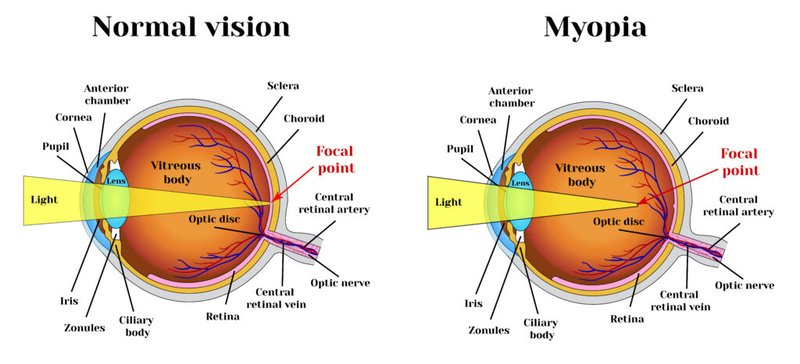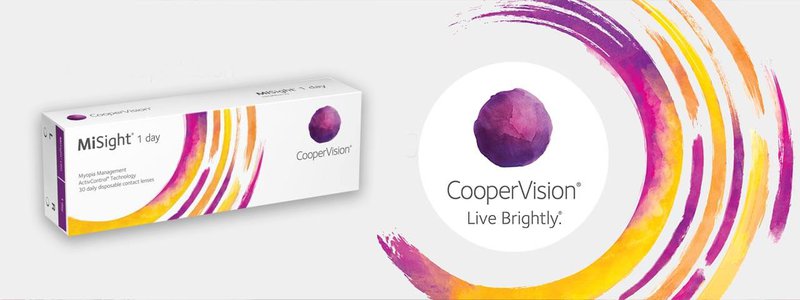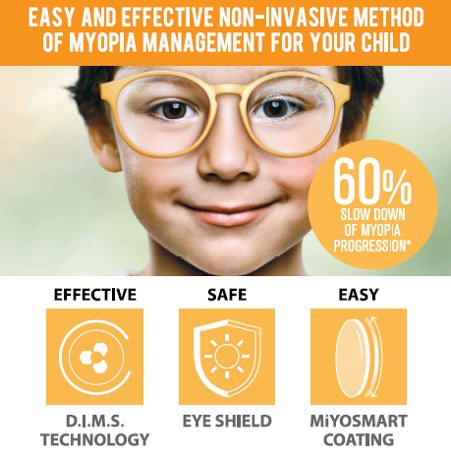What is Myopia?
Myopia, commonly known as nearsightedness, is a vision condition where close objects can be seen clearly, but objects at a distance appear blurry. It often occurs when the eyeball is too long or the cornea has too much curvature.
Myopia usually begins in childhood and can progress during the school-age years. Genetics play a significant role, but environmental factors such as extensive near work (like reading or screen time) and insufficient outdoor activity may contribute to its onset and progression. Regular eye exams can help monitor and manage myopia, and corrective lenses or contact lenses are common treatments. In some cases, interventions like orthokeratology or prescription eye drops may be recommended to slow down its progression.

What are the symptoms of Myopia?
Common symptoms of myopia include blurred vision when looking at distant objects, eye strain, headaches, and squinting. If you experience these symptoms, it's advisable to consult an eye care professional for a comprehensive eye exam. During the examination, the eye care provider will check your visual acuity, assess the degree of nearsightedness, and examine the overall health of your eyes. Regular eye check-ups are crucial for early detection and management of myopia.
Myopia in children is becoming more prevalent, possibly due to factors like increased screen time and reduced outdoor activities. It often starts in childhood and can progress during the school-age years. Regular eye exams are crucial for early detection, as children may not always express vision concerns. If myopia is identified, eyeglasses or contact lenses are common solutions. Additionally, interventions like atropine eye drops or orthokeratology may be recommended to manage its progression. Encouraging outdoor activities and implementing good screen time habits can also be beneficial.
In babies and children they may rub their eyes regularly, sit close to the TV, complain of headaches and/or eye strain, and may not see writing in the distance.
What are the causes of Myopia?
The primary causes of myopia include genetic factors, where family history plays a significant role. Environmental factors, such as prolonged near work activities (like reading or using screens) and insufficient outdoor exposure, are also associated with myopia development. The elongation of the eyeball or changes in the cornea's curvature contribute to the condition. Additionally, certain lifestyle and cultural factors may influence the prevalence of myopia in different populations.
What are the risk factors, associated conditions and progression of Myopia?
Myopia progression is associated with several risks, including an increased likelihood of developing more severe nearsightedness. Higher myopia is linked to an elevated risk of eye conditions like cataracts, glaucoma, and retinal detachment. Additionally, progressive myopia in children can lead to a higher prescription over time, potentially impacting daily activities. Regular eye check-ups and appropriate interventions, such as corrective lenses or myopia management strategies, can help mitigate these risks and maintain eye health.
How to manage Myopia?
MiSight Lenses
MiSight lenses are a type of contact lens designed for myopia management. They are specifically created to slow down the progression of myopia (nearsightedness) in children. MiSight lenses are part of a strategy known as myopia control, which aims to reduce the rate at which a child's prescription for glasses or contact lenses increases over time. These lenses typically incorporate a dual-focus design to help maintain clear distance vision while also reducing the stimulus causing the progression of myopia. It's important for individuals considering these lenses to consult with an eye care professional to determine if they are a suitable option based on the specific needs and circumstances.

Book your Eye Examination Today
Orthokeratology
Orthokeratology (Ortho-K) is a method used for myopia control. It involves the use of specially designed rigid gas permeable contact lenses that are worn overnight. These lenses temporarily reshape the cornea, providing clearer vision during the day without the need for glasses or contact lenses.
Ortho-K lenses are particularly used to slow down the progression of myopia in children and adolescents. The lenses exert gentle pressure on the cornea, influencing its shape. Regular use can help maintain clearer distance vision and potentially reduce the rate of myopia progression.
It's crucial to consult with an eye care professional to determine if orthokeratology is a suitable option based on individual eye health and lifestyle factors. Regular follow-up visits are also essential to monitor the effectiveness and safety of the treatment.
Book your Eye Examination Today
MiYOSMART Lenses
MiYOSMART lenses are another type of spectacle lens designed for myopia control. These lenses incorporate D.I.M.S. (Defocus Incorporated Multiple Segments) technology. This technology involves incorporating multiple zones into the lens, allowing for clear vision while simultaneously creating myopic defocus in the peripheral retina. The idea is to control myopia progression by altering the visual environment.
MiYOSMART lenses are often used in children to help slow down the progression of myopia. They are worn like regular eyeglasses and are part of the broader approach to myopia control, which aims to address the increasing prevalence of nearsightedness, especially in younger populations. As with any myopia control strategy, consultation with an eye care professional is crucial to determine suitability and monitor the effectiveness of the treatment.

